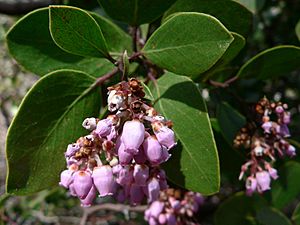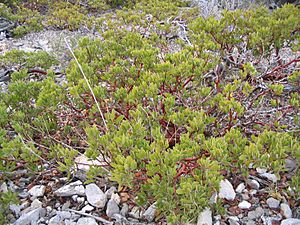Arctostaphylos facts for kids
Quick facts for kids Arctostaphylos |
|
|---|---|
 |
|
| Whiteleaf manzanita (Arctostaphylos viscida) | |
| Scientific classification |
|
| Kingdom: | Plantae |
| Clade: | Tracheophytes |
| Clade: | Angiosperms |
| Clade: | Eudicots |
| Clade: | Asterids |
| Order: | Ericales |
| Family: | Ericaceae |
| Subfamily: | Arbutoideae |
| Genus: | Arctostaphylos Adanson |
| Type species | |
| Arctostaphylos uva-ursi (Linnaeus) Sprengel
|
|
| Species | |
|
About 60, see text. |
|
Arctostaphylos ( from ἄρκτος árktos "bear" and σταφυλή staphulḗ "bunch of grapes") is a genus of plants comprising the manzanitas () and bearberries. They are shrubs or small trees.
There are about 60 species of Arctostaphylos, ranging from ground-hugging arctic, coastal, and mountain species to small trees up to 6 m tall. Most are evergreen (one species deciduous), with small oval leaves 1–7 cm long, arranged spirally on the stems. The flowers are bell-shaped, white or pale pink, and borne in small clusters of 2–20 together; flowering is in the spring. The fruit are small berries, ripening in the summer or autumn. The berries of some species are edible.
Arctostaphylos species are used as food plants by the larvae of some Lepidoptera species including Coleophora arctostaphyli (which feeds exclusively on A. uva-ursi) and Coleophora glaucella.
Contents
Distribution
Manzanitas, the bulk of Arctostaphylos species, are present in the chaparral biome of western North America, where they occur from southern British Columbia in Canada, Washington to California and New Mexico in the United States, and throughout much of northern and central Mexico.
Three species, the bearberries, A. alpina (alpine bearberry), A. rubra (red bearberry) and A. uva-ursi (common bearberry), have adapted to arctic and subarctic climates, and have a circumpolar distribution in northern North America, Asia and Europe.
An unusual association of manzanita occurs on Hood Mountain, in Sonoma County, California, where stands of pygmy forest dominated by Mendocino cypress are found.
Fossil record
One fossil fruit of †Arctostaphylos globula and several fossil fruits of †Arctostaphylos menzelii have been described from middle Miocene strata of the Fasterholt area near Silkeborg in Central Jutland, Denmark.
Cultivation
Cultivation is generally difficult due to fungal diseases, and often salinity and alkalinity. Overhead watering should be avoided in hot weather. Some cultivars are easier to grow.
Taxonomy
According to Philip V. Wells in The Jepson Manual and other sources, there are two subgenera of Arctostaphylos:
- Subgenus Micrococcus
- Sect. Micrococcus
- Arctostaphylos mendocinoensis Pygmy manzanita
- Arctostaphylos myrtifolia Ione manzanita
- Arctostaphylos nissenana Nissenan manzanita
- Arctostaphylos nummularia Glossyleaf manzanita
- Sect. Micrococcus
- Subgenus Arctostaphylos, which has 3 sections:
- Sect. Arctostaphylos
- Arctostaphylos alpina Alpine bearberry
- Arctostaphylos bakeri Baker's manzanita
- Arctostaphylos densiflora Sonoma manzanita
- Arctostaphylos edmundsii Little Sur manzanita
- Arctostaphylos franciscana Franciscan manzanita
- Arctostaphylos gabrielensis San Gabriel manzanita
- Arctostaphylos glauca Bigberry manzanita
- Arctostaphylos hispidula Gasquet manzanita
- Arctostaphylos hookeri Hooker's manzanita
- Arctostaphylos insularis Island manzanita
 Common bearberry Arctostaphylos uva-ursi
Common bearberry Arctostaphylos uva-ursi - Arctostaphylos klamathensis Klamath manzanita
- Arctostaphylos manzanita Common manzanita
- Arctostaphylos mewukka Indian manzanita
- Arctostaphylos nevadensis Pinemat manzanita
- Arctostaphylos parryana Parry manzanita
- Arctostaphylos patula Greenleaf manzanita
- Arctostaphylos pumila Sandmat manzanita
- Arctostaphylos pungens Pointleaf manzanita
- Arctostaphylos rudis Shagbark manzanita
- Arctostaphylos stanfordiana Stanford's manzanita
- Arctostaphylos uva-ursi Bearberry
- Arctostaphylos viscida Sticky manzanita
- Sect. Foliobracteata
- Arctostaphylos andersonii Santa Cruz manzanita
- Arctostaphylos auriculata Mount Diablo manzanita
- Arctostaphylos canescens Hoary manzanita
- Arctostaphylos catalinae Santa Catalina Island manzanita
- Arctostaphylos columbiana Hairy manzanita
- Arctostaphylos confertiflora Santa Rosa Island manzanita
- Arctostaphylos cruzensis La Cruz manzanita
- Arctostaphylos glandulosa Eastwood manzanita
- Arctostaphylos glutinosa Schreiber's manzanita
- Arctostaphylos hooveri Hoover's manzanita
- Arctostaphylos imbricata San Bruno Mountain manzanita
- Arctostaphylos luciana Santa Lucia manzanita
- Arctostaphylos malloryi Mallory's manzanita
- Arctostaphylos montaraensis Montara manzanita
- Arctostaphylos montereyensis Monterey manzanita
- Arctostaphylos morroensis Morro manzanita
- Arctostaphylos nortensis Del Norte manzanita
- Arctostaphylos obispoensis Serpentine manzanita
- Arctostaphylos osoensis Oso manzanita
- Arctostaphylos otayensis Otay manzanita
- Arctostaphylos pajaroensis Pajaro manzanita
- Arctostaphylos pallida Pallid manzanita
- Arctostaphylos pechoensis Pecho manzanita
- Arctostaphylos pilosula La Panzo manzanita
- Arctostaphylos purissima La Purissima manzanita
- Arctostaphylos refugioensis Refugio manzanita
- Arctostaphylos regismontana Kings Mountain manzanita
- Arctostaphylos silvicola Bonny Doon manzanita
- Arctostaphylos tomentosa Woolyleaf manzanita
- Arctostaphylos virgata Bolinas manzanita
- Arctostaphylos viridissima Whitehair manzanita
- Arctostaphylos wellsii Wells' manzanita
- Sect. Pictobracteata
- Arctostaphylos pringlei Pringle manzanita
- Sect. Arctostaphylos
- Unassigned
- Arctostaphylos rainbowensis Rainbow manzanita
- Arctostaphylos gabilanensis Gabilan manzanita
- Arctostaphylos ohloneana Ohlone manzanita
- Synonyms
- Arctostaphylos bicolor is generally considered Xylococcus bicolor
- Arctostaphylos crustacea is generally considered Arctostaphylos tomentosa ssp. crustacea
See also the closely related genus Comarostaphylis, previously often included in Arctostaphylos.
See also
 In Spanish: Arctostaphylos para niños
In Spanish: Arctostaphylos para niños



